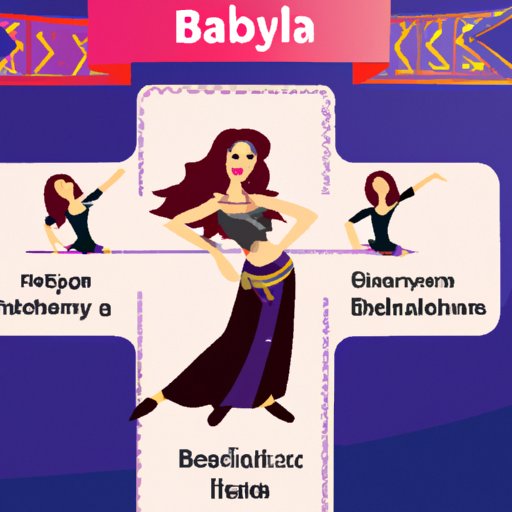Introduction
Belly dancing is a captivating form of dance that originated in the Middle East and North Africa. It is often referred to as “raqs sharqi”, which means “dance of the east” in Arabic. This article will explore the history, benefits, different types, popular performers, and traditional and cultural aspects of belly dancing.
A History of Belly Dancing
The origins of belly dancing are difficult to trace, due to the lack of written records from the time period. However, it is believed to have its roots in ancient fertility cults and religious practices. It is thought to have been used as a way to celebrate and honor goddesses, fertility, and femininity.
As trade and migration spread across the Mediterranean region, so too did the practice of belly dancing. From Egypt to Turkey and beyond, each culture developed its own unique style of belly dancing. In the 19th century, belly dancing became increasingly popular in Europe and the United States, with performances featuring dancers from the Middle East and North Africa.
Today, belly dancing is enjoyed by people all over the world. It has become a popular form of fitness, as well as an art form that is performed on stage and in competitions.

The Benefits of Belly Dancing
Belly dancing offers a variety of physical, mental, and social benefits. Studies have shown that regular practice of belly dancing can improve physical strength, endurance, flexibility, coordination, and balance. It can also help to reduce stress and anxiety, as well as improve body image and self-confidence.
In addition to the physical benefits, belly dancing also has social benefits. It encourages community building, as classes and performances often foster a sense of camaraderie and support amongst participants. Belly dancing also provides a creative outlet for self-expression, allowing dancers to express their emotions and feelings through movement.
Types of Belly Dancing
There are many different styles of belly dancing from around the world. Here are some of the most popular:
- Classical Egyptian Style: This is the most traditional form of belly dancing, characterized by fast and intricate hip movements and shimmies.
- American Cabaret Style: This style originated in the United States, and is characterized by slow, sensual movements and isolations.
- Turkish Oriental Style: This style combines traditional Middle Eastern moves with modern influences from other dance forms, such as jazz and hip-hop.
- Tribal Fusion: This style is a blend of traditional belly dancing moves with contemporary music and influences from other dance forms, such as hip hop and African dance.

How to Get Started with Belly Dancing
If you’re interested in learning how to belly dance, there are a few steps to get started. First, find a class or teacher who specializes in belly dancing. Many belly dancing classes are available online, or you can search for classes in your local area. Once you’ve found a class or teacher, learn the basics of belly dancing. This includes basic moves, posture, and technique. Finally, develop your own style of belly dancing by experimenting with different music and movements.
Popular Belly Dancing Performers
There are many talented belly dancers in the world today. Here are a few of the most popular:
- Sohaila: Sohaila is a professional belly dancer from Egypt who has been performing since she was a child. She is known for her graceful and captivating performances.
- Rachel Brice: Rachel Brice is a world-renowned belly dancer from the United States. She is known for her innovative fusion of traditional belly dancing and modern influences.
- Aida Nour: Aida Nour is a professional belly dancer from Tunisia. She is known for her stunningly beautiful costumes and mesmerizing performances.
- Kami Liddle: Kami Liddle is an American belly dancer who has been performing for over 20 years. She is known for her dynamic and energetic performances.

Traditional and Cultural Aspects of Belly Dancing
In addition to its use as a form of entertainment, belly dancing has a long history of being used in ancient religious practices. In some cultures, it was used to honor goddesses and invoke fertility. It was also used as a form of healing and spiritual cleansing.
Belly dancing has a deep cultural significance in many countries, including Egypt, Turkey, and Lebanon. In these countries, it is often seen as a celebration of femininity and female empowerment. Music plays an important role in belly dancing, as each style has its own unique musical accompaniment.
Conclusion
In conclusion, belly dancing is an ancient art form with many physical, mental and social benefits. It has its roots in ancient fertility cults and religious practices, and has since spread throughout the world. There are many different styles of belly dancing, from classical Egyptian to Tribal Fusion, and many talented performers. Belly dancing also has a rich cultural and traditional history, with many countries viewing it as a celebration of femininity and female empowerment. Whether you’re looking for a fun way to stay fit or a creative outlet for self-expression, belly dancing is a great choice.
Final Thoughts
Belly dancing is a beautiful and mesmerizing form of dance that has something to offer everyone. Whether you want to get in shape, express yourself creatively, or just have fun, belly dancing can provide a unique and rewarding experience.
(Note: Is this article not meeting your expectations? Do you have knowledge or insights to share? Unlock new opportunities and expand your reach by joining our authors team. Click Registration to join us and share your expertise with our readers.)
